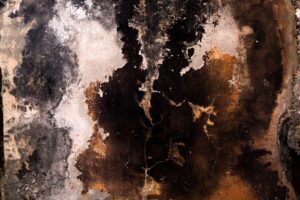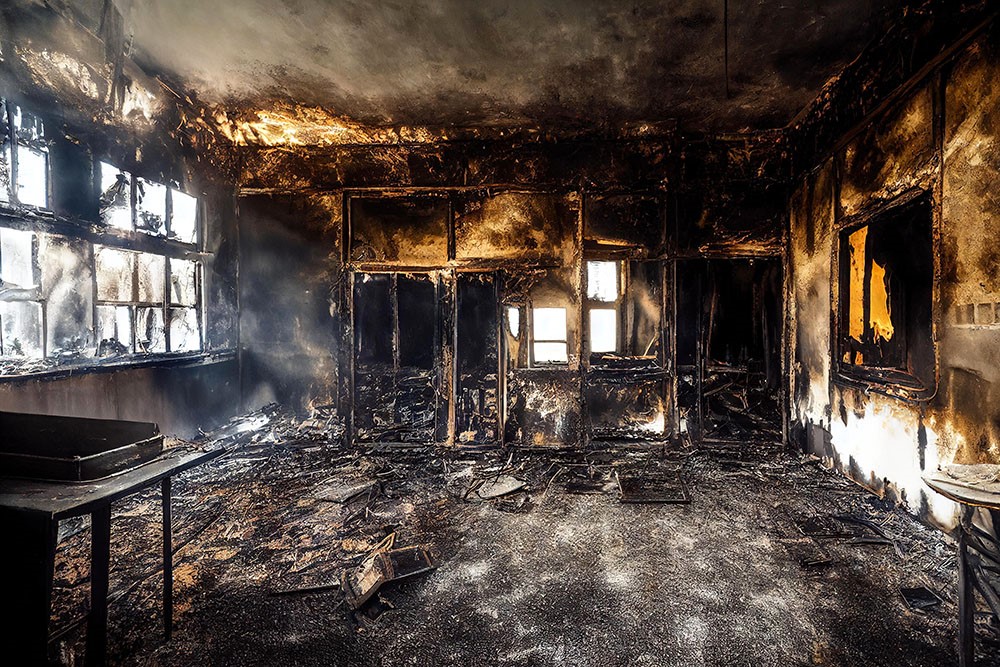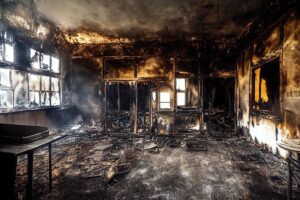How Do You Clean Fire Damaged Concrete? Really You Know That? Fire damage can significantly impact concrete surfaces, leaving them scorched, discolored, and structurally compromised. Concrete, known for its fire-resistant qualities, can still suffer from heat-induced damage, leading to unsightly stains and potential weakening of its structural integrity.
Addressing this damage promptly is crucial to restore both the appearance and functionality of the concrete. This comprehensive guide will walk you through the necessary steps to clean and restore fire-damaged concrete effectively, ensuring it remains safe and aesthetically pleasing.
Cleaning fire-damaged concrete involves removing soot and smoke stains, neutralizing harmful chemicals, and sealing the surface to restore its appearance and integrity.

Detail of a wall destroyed by fire
Causes of Fire Damage on Concrete Surfaces
During a fire, concrete surfaces are subjected to extremely high temperatures, which can alter the material’s finish and composition. This exposure results in several types of damage. Scorching occurs when direct flames or intense heat dehydrate and oxidize the concrete, often leaving the surface discolored with burnt orange or yellowish tones.
Cracking happens as the concrete expands and dehydrates, causing it to split and delaminate from the substrate. Discoloration is another common issue, where chemical changes, particularly in compounds containing iron, turn the concrete pink. Carbonation, the breakdown of cement paste leading to reduced alkalinity, further deteriorates the concrete’s surface. Additionally, fire retardants and other chemicals used to extinguish the fire can erode the concrete, compounding the damage.
Safety Precautions for Cleaning Fire Damaged Concrete
Before starting the cleaning process, it’s crucial to prioritize safety. Wear protective clothing such as gloves, long sleeves, pants, and closed-toe shoes to prevent skin contact with cleaning products. Ensure the area is well-ventilated to avoid inhaling chemical fumes, and take frequent breaks for fresh air.
Follow all instructions on cleaning product labels carefully, and never mix chemicals unless specified. To prevent environmental contamination, contain spray and splash by closing off or masking any drains.
Equipment Needed for Cleaning
Having the right equipment makes the cleaning process more efficient. A heavy-duty gas pressure washer with at least 3000 PSI or an electric pressure washer over 2000 PSI is ideal for lifting smoke stains. Use a stiff-bristled non-metallic brush to scrub the concrete without causing scratches.
Essential tools also include a bucket, rags, and a putty knife for hand cleaning and tackling tough stains in crevices. For cleaning agents, select a heavy-duty alkaline degreaser containing sodium metasilicate or ammonium hydroxide to lift oily smoke deposits, and a neutralizing chemical like sodium carbonate to remove traces of cleaning agents. Finally, a concrete sealer is necessary to protect the cleaned surface.
Cleaning Steps for Fire Damaged Concrete
Initial Cleaning
Start by lightly pressure washing the affected areas to remove any loose concrete particles, dust, or debris on the surface. Apply a degreasing cleaner to scorched areas and let it soak for 5-10 minutes to help lift stains from burnt organic compounds.
Vigorously scrub the stains with a non-metallic stiff-bristle brush, applying moderate pressure, and rinse thoroughly with clean water using the pressure washer wand held 6-8 inches away to avoid further damage. Repeat this process until the discoloration has been removed. Although heavily scorched concrete may never return to its original color, scrubbing will dramatically improve its appearance.
Removing Smoke and Soot Stains
To clean smoke-stained areas, mix a solution of 1 part household ammonia to 3 parts water. Apply this solution to the stained concrete using a bucket and brush or rag, and let it sit for 3-5 minutes to penetrate and dissolve the oily soot deposits.
Agitate the solution by scrubbing in a circular motion with a non-metallic brush or rag, then rinse thoroughly with clean water using moderate pressure from the pressure washer nozzle. Repeat as necessary until the smoke stains have been removed, as several rounds of scrubbing and rinsing are usually required.
Neutralizing Chemical Exposure
If the concrete appears eroded or etched from fire suppressant chemicals, sprinkle granulated sodium carbonate lightly but evenly over the affected areas. Using a garden hose on a low-pressure setting, lightly wet the concrete surface to activate the sodium carbonate and let the solution sit for 15 minutes. Thoroughly rinse off the area with clean water to neutralize and remove any remaining harsh chemicals on the concrete surface.
Sealing and Protecting Cleaned Concrete
After the pressure washing, scrubbing, and neutralizing process, allow the concrete to dry fully for at least 24-48 hours. Sealing damp concrete can prevent proper bonding. Once dry, apply a concrete sealer using a paint roller and brush, spreading it evenly across the surface.
This will help prevent future smoke stains from absorbing into the concrete pores. Choose a sealer suited to your needs, such as a penetrating or acrylic-based sealer, and allow it to fully cure as recommended on the product instructions, typically 24-48 hours.
Proper cleaning and sealing are essential to restoring fire-damaged concrete and preventing further deterioration. While the process requires an intensive investment of time and labor, bringing your concrete back to life is well worth the effort and will help your home recover from this unfortunate event.
Conclusion
Cleaning fire-damaged concrete is a meticulous process that involves several steps, including removing soot and smoke stains, neutralizing harmful chemicals, and applying a protective sealer. By following these guidelines, you can restore the appearance and integrity of your concrete surfaces, ensuring they remain safe and aesthetically pleasing. Remember, safety is paramount, so always use appropriate protective gear and consider professional help for extensive damage.
FAQs How Do You Clean Fire Damaged Concrete
Q1: Can fire-damaged concrete be completely restored?
Yes, fire-damaged concrete can often be restored to a significant extent, but it depends on the severity of the damage. While surface stains and minor cracking can be addressed through cleaning and sealing, heavily scorched or structurally compromised concrete may require professional assessment and potential replacement. Consulting with a structural engineer can provide clarity on whether restoration or replacement is necessary.
Q2: What household items can be used to clean soot off concrete?
Household ammonia mixed with water can be an effective solution for cleaning soot off concrete. Mix 1 part ammonia to 3 parts water, apply it to the stained area, let it sit for a few minutes, then scrub and rinse thoroughly. However, always ensure proper ventilation and wear protective gear when using ammonia, as its fumes can be hazardous.
Q3: Is it safe to use a pressure washer on fire-damaged concrete?
Yes, using a pressure washer is safe and effective for cleaning fire-damaged concrete, provided you use the correct settings. A heavy-duty gas pressure washer with at least 3000 PSI or an electric pressure washer over 2000 PSI is ideal. Ensure you hold the pressure washer wand 6-8 inches away from the surface to avoid causing further damage.
Q4: How do I know if fire damaged concrete needs to be replaced?
If the concrete has extensive cracking, severe discoloration, or appears structurally compromised, it should be inspected by a structural engineer. They can determine whether the concrete can be restored or if it needs to be replaced. Safety should always be the priority, and professional assessment is crucial for heavily damaged concrete.
Q5: Can I use household bleach to clean fire damaged concrete?
While bleach can be used to clean certain types of stains, it is not recommended for fire-damaged concrete due to its harsh chemical nature. Bleach can damage the concrete surface and pose safety risks if not handled properly. Instead, use degreasing cleaners specifically designed for removing smoke and soot stains from concrete to ensure effective and safe cleaning.


